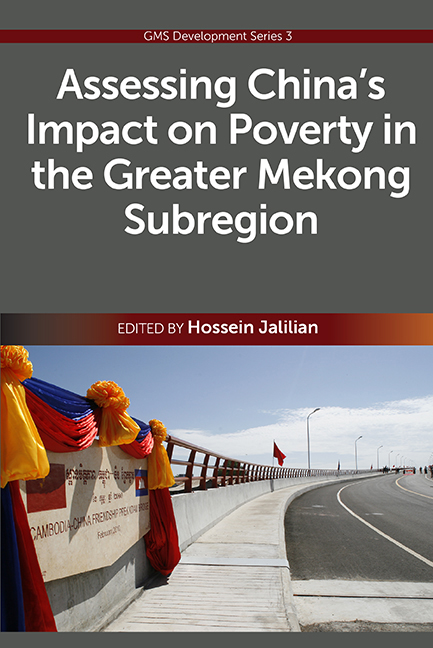Book contents
- Frontmatter
- Contents
- List of Figures, Tables and Boxes
- Foreword
- List of Contributors
- PART I The Context
- 1 Assessing China's Impact on Poverty in the Greater Mekong Subregion: An Introduction
- 2 Assessing China's Impact on Poverty Reduction in the Greater Mekong Subregion: Literature Review
- PART II CHINA AND THE GMS-4
- PART III THE GMS-4 AND CHINA
- Index
2 - Assessing China's Impact on Poverty Reduction in the Greater Mekong Subregion: Literature Review
from PART I - The Context
Published online by Cambridge University Press: 21 October 2015
- Frontmatter
- Contents
- List of Figures, Tables and Boxes
- Foreword
- List of Contributors
- PART I The Context
- 1 Assessing China's Impact on Poverty in the Greater Mekong Subregion: An Introduction
- 2 Assessing China's Impact on Poverty Reduction in the Greater Mekong Subregion: Literature Review
- PART II CHINA AND THE GMS-4
- PART III THE GMS-4 AND CHINA
- Index
Summary
This literature review, comprising four main sections, discusses the key conceptual and empirical debates around poverty, the rise of China, and the Greater Mekong Subregion (GMS). Principally, the literature on economic growth and poverty reduction in general — and in the GMS region in particular — is reviewed. These key issues are then linked to trade, investment and official development assistance (ODA) as they are the three most important factors that drive national and regional growth. All GMS member countries (except Yunnan province and the Guangxi region of China) are member countries of the Association of Southeast Asian Nations (ASEAN). Therefore the literature review looks at China's growth, its overall impact on ASEAN and its specific impact in terms of trade, investment and ODA in the region on individual GMS countries. This overview gives an academic background to the key issues addressed in the following country studies that follow.
ECONOMIC GROWTH AND POVERTY REDUCTION
While there is a consensus that pro-poor growth strategies play a crucial role in poverty reduction, there is wide debate about what exactly constitutes pro-poor growth and how it can be measured (Ravallion and Chen 2003; Kakwani and Pernia 2000; Klasen 2004). The traditional orthodox economics view (for example, Dollar and Kraay 2001; Ravallion and Chen 2003) suggests that any growth that reduces poverty is pro-poor — unless the incomes of poor people stagnate or decline — irrespective of inequality.
Another view holds that, as poor people are the least likely to share the benefits of growth, pursuing policies that actively focus on reducing poverty through “inclusive growth” should be made a priority. They argue that pro-poor growth should focus not just on reducing poverty, but also inequality. White and Anderson (2000), for example, define pro-poor growth as growth where poor households enjoy higher income growth than other segments of society. Kakwani and Pernia (2000) suggest that pro-poor growth not only reduces poverty, but also results in a more equitable distribution of income. H. Son (2007) adopts the equitable distribution of income definition proposed by Kakwani and Pernia (2000) and examines this issue by using a cross-country analysis of seventeen Asian countries during the period 1981 to 2001.
- Type
- Chapter
- Information
- Publisher: ISEAS–Yusof Ishak InstitutePrint publication year: 2013



